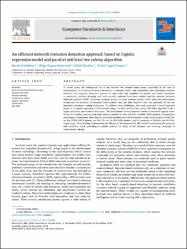| dc.contributor.author | Kolukısa, Burak | |
| dc.contributor.author | Dedeturk, Bilge Kagan | |
| dc.contributor.author | Hacilar, Hilal | |
| dc.contributor.author | Gungor, Vehbi Cagri | |
| dc.date.accessioned | 2024-01-04T09:02:38Z | |
| dc.date.available | 2024-01-04T09:02:38Z | |
| dc.date.issued | 2024 | en_US |
| dc.identifier.issn | 0920-5489 | |
| dc.identifier.issn | 1872-7018 | |
| dc.identifier.other | WOS:001127995400001 | |
| dc.identifier.uri | https://doi.org/10.1016/j.csi.2023.103808 | |
| dc.identifier.uri | https://hdl.handle.net/20.500.12573/1874 | |
| dc.description.abstract | In recent years, the widespread use of the Internet has created many issues, especially in the area of cybersecurity. It is critical to detect intrusions in network traffic, and researchers have developed network intrusion and anomaly detection systems to cope with high numbers of attacks and attack variations. In particular, machine learning and meta-heuristic methods have been widely used for network intrusion detection systems (NIDS). However, existing studies on these systems usually suffer from low performance results such as accuracy, F1-measure, false positive rate, and false negative rate, and generally do not use automatic parameter tuning techniques. To address these challenges, this study proposes a novel approach based on a logistic regression model trained using a parallel artificial bee colony (LR-ABC) algorithm with a hyper-parameter optimization technique. The performance of the proposed model is evaluated against state -of-the-art machine learning and deep learning models on two publicly available NIDS datasets. Comparative performance evaluations show that the proposed method achieved satisfactory results with accuracy of 88.25% on the UNSW-NB15 dataset and 90.11% on the NSL-KDD dataset, and F1-measures of 88.26% and 90.15%, respectively. These findings demonstrate the efficacy of the proposed LR-ABC model in enhancing the accuracy and reliability, while providing a scalable solution to adapt to the dynamic and evolving landscape of cybersecurity threats. | en_US |
| dc.language.iso | eng | en_US |
| dc.publisher | ELSEVIER | en_US |
| dc.relation.isversionof | 10.1016/j.csi.2023.103808 | en_US |
| dc.rights | info:eu-repo/semantics/closedAccess | en_US |
| dc.subject | Network intrusion detection system | en_US |
| dc.subject | Anomaly detection | en_US |
| dc.subject | Machine learning | en_US |
| dc.subject | Artificial bee colony | en_US |
| dc.subject | UNSW-NB15 | en_US |
| dc.subject | NSL-KDD | en_US |
| dc.subject | Logistic regression | en_US |
| dc.title | An efficient network intrusion detection approach based on logistic regression model and parallel artificial bee colony algorithm | en_US |
| dc.type | article | en_US |
| dc.contributor.department | AGÜ, Mühendislik Fakültesi, Bilgisayar Mühendisliği Bölümü | en_US |
| dc.contributor.authorID | 0000-0003-0423-4595 | en_US |
| dc.contributor.authorID | 0000-0003-0803-8372 | en_US |
| dc.contributor.institutionauthor | Kolukısa, Burak | |
| dc.contributor.institutionauthor | Hacilar, Hilal | |
| dc.contributor.institutionauthor | Gungor, Vehbi Cagri | |
| dc.identifier.volume | 89 | en_US |
| dc.identifier.startpage | 1 | en_US |
| dc.identifier.endpage | 9 | en_US |
| dc.relation.journal | COMPUTER STANDARDS & INTERFACES | en_US |
| dc.relation.publicationcategory | Makale - Uluslararası Hakemli Dergi - Kurum Öğretim Elemanı | en_US |


















